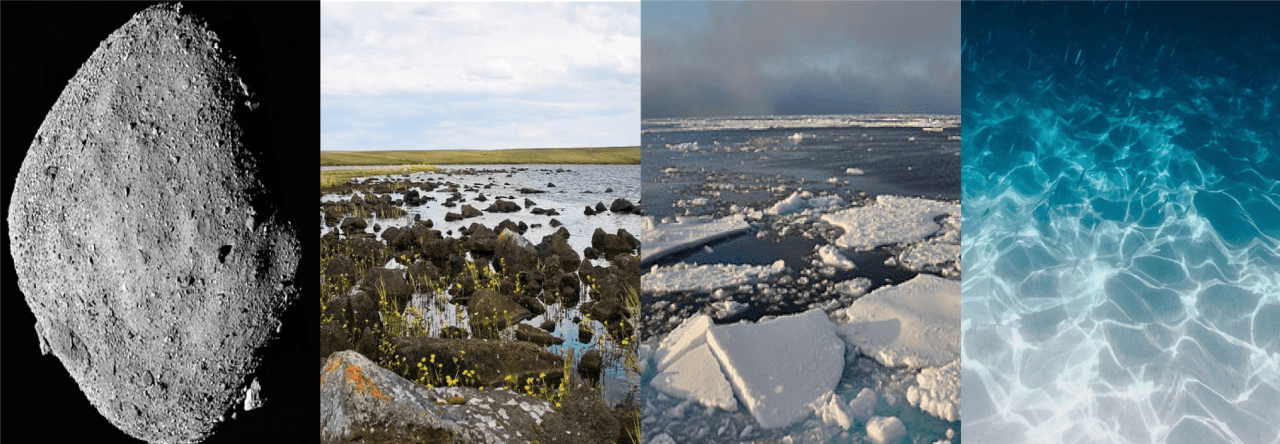Prebiotic synthesis of volatile organic compounds: molecular and
compound-specific isotopic analyses of OSIRIS-REx returned “Bennu” samples

One of the key goals of NASA’s OSIRIS-REx mission is to analyze low molecular weight volatile organic compounds (VOCs) collected from samples of Asteroid Bennu. These VOCs, including hydrocarbons, acids, ketones, aldehydes, amines, esters, and alcohols, are essential building blocks for complex organic compounds like amino acids. By studying these compounds, scientists hope to gain insights into the origin and evolution of prebiotic organic compounds and their potential interstellar heritage. Our lab will employ streamlined analytical methodologies to minimize sample consumption and contamination while maximizing the extraction of information. This involves the use of three analytical platforms to extract and analyze the volatiles, with the potential of further exploring higher molecular weight or less volatile organics in the residual samples. Our ultimate goal is to generate critical new data on Bennu’s organic chemistry using a relatively small sample mass.
Demystifying the human evolution, Arctic vegetation, and tundra fire activities using the longest known sedimentary records from Seward Peninsula, Alaska

In 2019, our lab conducted a coring expedition at Imuruk Lake in Seward Peninsula, Alaska, acquiring an extensive sedimentary record spanning approximately 240,000 years. To date, this record stands as the oldest and longest continuous Arctic lake sedimentary record, offering UNIQUE opportunities to investigate climatic/environmental changes, as well as human evolutionary history over the Late Quaternary glacial-interglacial cycling. Using the longest known sediment records from Imuruk Lake, our lab is focusing on generating high-quality proxy records with several overarching project themes including (1) elucidating the primary cause of last mass extinction event, around 100,000 years ago, when approximately 65% of the global megafauna (i.e., large animals weighing over >45 kg or 100 lb) went extinct; (2) determining the timing of human arrival in North America to test the ‘Standstill hypothesis’ versus ‘Arctic Tundra Fire Hypothesis’; and (3) understanding the Arctic vegetation, hydrological cycling, and fire activities in response to past climate change.
Comprehensive analysis of alkenones and alkenoates by reversed phase HPLC-MS with unprecedented sensitivity and selectivity

Unsaturation ratios of long-chain alkenones, particularly the UK37′ index, have been widely and successfully used for reconstructing past sea and lake surface temperature in the past 40 years. Alkenones are primarily analyzed using gas chromatograph flame ionization detection (GC-FID). However, the application of GC-FID analysis is often difficult in samples with depleted alkenone abundance and/or samples containing non-saponifiable contaminants (common in high latitude and marginal ocean sites, lake sediments etc). To address these issues, a reversed phase HPLC-single quadrupole(SQ)MS method was proudly developed from our lab, offering superior sensitivity, mass selectivity, and ease of operation (Liao et al., 2022). Currently, our lab is focusing on the development of an HPLC-triple quadrupole (TQ)MS method to further improve alkenone analysis in complex samples. This approach, with multiple reaction monitoring (MRM), enhances selectivity and eliminates matrix contaminations, promising comprehensive and quantitative alkenone analysis. Overall, we seek to refine alkenone analysis by overcoming current challenges, ultimately enhancing the accuracy and scope of paleo-temperature reconstructions.
Related paper(s):
Liao et al. (2023) Talanta, Comprehensive analysis of alkenones by reversed-phase HPLC-MS with unprecedented selectivity, linearity and sensitivity
Reconstructing the variability of Arctic sea ice in Earth’s history: Lessons from the past and for the future

In the Arctic where warming is occurring at an unprecedented speed, the loss of sea ice extent is expected to accelerate in the future, strongly impacting regional and global climate, environment, and ecosystem. State-of-the-art climate models coupled with sea ice dynamics provide us insights to Arctic sea ice change in a warming world. However, large discrepancies between models and fundamental uncertainties due to Earth’s complex interactions/feedbacks continue to cloud our view of the fate of Arctic sea ice. Here, we focus on using integrated approaches of sea ice proxies (organic biomarkers, microfossils, sedimentological evidence) and Earth climate models to systematically reconstruct the past Arctic sea ice – its occurrence, extent, and concentration – during key global warming periods. Our goal is to examine the natural variability of Arctic sea ice and its key controlling factors, with important implications for sea ice projections in the future changing climate.
Related paper(s):
Wang et al. (2021) Nat. Comm. Group 2i Isochrysidales produce characteristic alkenones reflecting sea ice distribution
